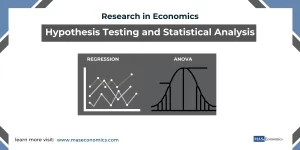In economics, data is the cornerstone of all research, providing the empirical foundation for testing theories, modeling economic behavior, and informing policy decisions. Without reliable data, even the most sophisticated economic models are rendered useless. Therefore, understanding the various data collection techniques in economics is critical for conducting accurate and meaningful research.
Economists use a range of data collection methods to gather information on markets, businesses, governments, and households. These methods can be broadly categorized into two types: primary and secondary data collection. Each method offers unique advantages and is suited to specific types of economic research.
In this article, we will explore both primary and secondary data collection techniques, discuss methods like surveys, interviews, experiments, and government data, and provide guidance on when to use each approach. By the end, you’ll understand how to design effective data collection strategies that yield reliable, relevant, and accurate data for economic analysis.
Primary vs. Secondary Data Collection in Economics
Before diving into specific techniques, it’s important to distinguish between primary and secondary data collection methods.
Primary Data Collection
Primary data refers to information collected firsthand by the researcher for the specific purpose of their study. This type of data is highly customizable and can be tailored to meet the exact needs of the research. However, collecting primary data can be time-consuming and expensive, requiring careful planning and execution.
Example of Primary Data: Survey on Consumer Spending
An economist interested in studying consumer spending patterns might design a survey to gather direct information from households. This data is not available from other sources and is specifically collected to address the research question at hand.
Secondary Data Collection
Secondary data involves using information that has already been collected by other researchers, institutions, or organizations. This data can include government statistics, historical records, or previously published academic research. Secondary data is often easier and faster to obtain, but it may not always be tailored to the specific needs of a study.
Example of Secondary Data: National Income Statistics
If an economist wants to analyze trends in national income, they might use secondary data from a government database, such as the World Bank or a national statistics bureau, which regularly publishes GDP figures and other economic indicators.
Primary Data Collection Methods in Economics
Primary data collection is essential when existing data does not adequately address the research question, or when new insights are required. There are several common methods used in economics for collecting primary data.
Surveys and Questionnaires
Surveys are one of the most widely used methods for collecting primary data in economics. They allow researchers to gather information from a large number of respondents about behaviors, preferences, and opinions. Surveys can be distributed online, via telephone, by mail, or in person.
Example: Survey on Wage Growth
An economist interested in understanding wage growth across different industries might design a survey to collect information directly from workers about their wages, job satisfaction, and working conditions. By analyzing this data, the researcher can identify trends and relationships between variables such as wage growth and education levels.
When to Use Surveys:
- When you need data from a large group of people.
- When studying opinions, behaviors, or preferences.
- When existing data does not provide the specific information required.
Designing Effective Surveys:
- Keep questions clear and concise.
- Use a mix of open-ended and closed-ended questions.
- Ensure that the sample population is representative of the larger group you are studying.
Interviews
Interviews are another primary data collection method used in economics, particularly for in-depth qualitative research. In interviews, researchers ask participants detailed questions, allowing them to gain insights into individual perspectives, motivations, and experiences.
Example: Interviews with Business Leaders
To understand how businesses make investment decisions, an economist might conduct interviews with CEOs or CFOs of major companies. These interviews provide rich, detailed insights into factors influencing corporate investment that may not be captured through quantitative data alone.
When to Use Interviews:
- When seeking detailed, qualitative insights.
- When researching niche or hard-to-reach populations (e.g., business executives, policymakers).
- When studying complex decision-making processes.
Conducting Effective Interviews:
- Develop open-ended questions to encourage detailed responses.
- Use a semi-structured format to allow flexibility while keeping the conversation on track.
- Record interviews (with consent) to ensure accurate data collection.
Experiments
Experiments are a more controlled form of primary data collection in which researchers manipulate one or more variables to observe their effects on other variables. In economics, experimental research is often conducted in laboratories or as field experiments in real-world settings.
Example: Experimental Study on Consumer Behavior
An economist studying consumer behavior might set up an experiment where participants are given different price points for the same product and observe how price changes affect purchasing decisions. This type of research can reveal how consumers respond to price fluctuations in a controlled setting.
When to Use Experiments:
- When you need to establish cause-and-effect relationships.
- When testing economic theories in a controlled environment.
- When observing how specific changes impact behavior.
Designing Effective Experiments:
- Clearly define your independent and dependent variables.
- Use control groups to isolate the effects of your manipulated variables.
- Ensure that the experimental conditions mimic real-world settings as closely as possible.
Secondary Data Collection Methods in Economics
While primary data collection is sometimes necessary, secondary data is often used in economics due to its availability and convenience. Secondary data collection involves sourcing information from published databases, reports, or other external sources.
Government Data
Government agencies are a rich source of secondary data for economists. National and international organizations regularly publish economic data, including GDP figures, unemployment rates, inflation statistics, and trade balances.
Example: Analyzing Inflation Using Government Data
An economist studying inflation might use data from a government database, such as the U.S. Bureau of Labor Statistics (BLS), which tracks monthly Consumer Price Index (CPI) data. This secondary data allows the researcher to analyze long-term inflation trends without needing to collect primary data.
When to Use Government Data:
- When you need large, standardized datasets.
- When studying macroeconomic indicators (e.g., GDP, inflation).
- When primary data collection is not feasible due to time or budget constraints.
Accessing Government Data:
- Visit government websites (e.g., World Bank, OECD, BLS).
- Use economic databases like FRED (Federal Reserve Economic Data) for U.S. economic indicators.
- Always verify the data source and ensure the data is relevant and up-to-date.
Published Research and Financial Reports
In addition to government data, economists often rely on academic publications, financial reports, and industry studies. These sources provide valuable secondary data for understanding specific sectors, financial markets, or international trade.
Example: Using Industry Reports to Analyze the Technology Sector
An economist researching the technology industry might use reports published by financial firms or consulting agencies, such as McKinsey or Deloitte. These reports often include data on market trends, investment levels, and technological innovations, offering insights that are difficult to obtain through primary data collection.
When to Use Published Research and Reports:
- When seeking specific industry insights.
- When analyzing financial markets or international trade.
- When primary data is not available for niche sectors.
- Use academic databases like JSTOR or Google Scholar.
Finding Relevant Reports:
- Explore industry-specific databases and publications.
- Ensure that the reports are from reputable, unbiased sources.
Designing an Effective Data Collection Strategy in Economics
Choosing the right data collection technique depends on the research question, the available resources, and the scope of the study. Here are key considerations when designing a data collection strategy:
Define the Research Question
Start by clearly defining the research question. For example, if you are studying the effects of monetary policy on inflation, determine whether existing data (secondary) can provide the insights you need or if you require new data (primary).
Consider Time and Resources
Primary data collection is often more resource-intensive than secondary data collection. If time and budget are limited, secondary data may be a better option. For example, using government data on interest rates and inflation might suffice for an analysis of monetary policy.
Determine Data Relevance
Ensure that the data you collect—whether primary or secondary—is relevant to your research question. For instance, if you’re studying consumer behavior, collecting survey data from households may be more relevant than analyzing secondary macroeconomic data.
Combine Methods When Needed
In many cases, a combination of primary and secondary data collection methods yields the best results. For example, you might use surveys to collect primary data on consumer spending and combine this with secondary data from government reports on household income.
Conclusion
Data collection in economics is a critical part of the research process, as it provides the foundation for testing theories, building models, and informing policy decisions. Whether you’re collecting primary data through surveys, interviews, or experiments, or using secondary data from government sources and published reports, it’s essential to choose the right method for your research question.
By designing an effective data collection strategy and selecting the appropriate techniques, economists can gather the information they need to conduct rigorous, insightful research that contributes to the advancement of economic knowledge.
FAQs:
What is primary data collection in economics?
Primary data collection involves gathering data firsthand by the researcher for a specific study. This data is collected directly through methods like surveys, interviews, and experiments, and it is tailored to address the specific research question.
What is secondary data collection in economics?
Secondary data collection involves using data that has already been gathered by other researchers, organizations, or institutions. Examples include government statistics, historical records, and previously published research.
When should primary data collection be used in economics?
Primary data collection should be used when existing data does not adequately address the research question or when specific, customized insights are needed. It’s ideal for studies that require new or unique data not available from secondary sources.
What are the most common primary data collection methods in economics?
The most common primary data collection methods include surveys, interviews, and experiments. Surveys collect information from large groups, interviews provide in-depth qualitative insights, and experiments test cause-and-effect relationships in controlled settings.
How are surveys used in economic research?
Surveys are used to collect data from a large group of people on topics such as consumer behavior, wage growth, or spending habits. They can be conducted online, in person, via telephone, or by mail.
When should interviews be used in economic research?
Interviews are used when detailed, qualitative insights are needed, such as when researching decision-making processes or gathering information from niche populations like business executives or policymakers.
What is an example of an experiment in economic research?
An experiment in economic research might involve manipulating one variable, such as price, to observe its effect on consumer behavior. For example, researchers might set up an experiment to test how price changes impact purchasing decisions in a controlled setting.
What is secondary data, and when is it used in economics?
Secondary data refers to data that has already been collected by others, such as government agencies or research institutions. It is often used in economics for analyzing large datasets, macroeconomic indicators, or trends in areas like inflation or GDP growth.
Where can economists find secondary data?
Economists can find secondary data from sources such as government websites (e.g., the World Bank, U.S. Bureau of Labor Statistics), economic databases like FRED, and industry reports published by consulting firms or academic institutions.
How do you choose between primary and secondary data collection methods?
The choice between primary and secondary data collection depends on the research question, the resources available, and the specificity of the data needed. Primary data is ideal when tailored information is required, while secondary data is useful for broad, readily available datasets.
Thanks for reading! Share this with friends and spread the knowledge if you found it helpful.
Happy learning with MASEconomics




